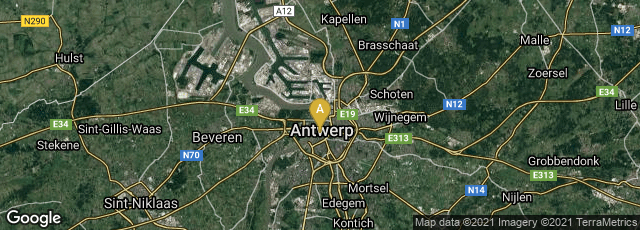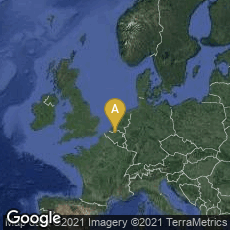

A: Antwerpen, Vlaanderen, Belgium
Belgian Jesuit mathematician, physicist and architect François d'Aguilon published Opticorum libri sex philosophis juxta ac mathematicis utiles in Antwerp at the Officina Plantiniana in 1613. Intended for use in Jesuit schools, Aguilon’s work was primarily a synthesis of classical and modern writings on optics; however, it also contained the first discussion of the stereographic process (which Aguilon named), one of the earliest presentations of the red-yellow-blue color system, an original theory of binocular vision and the first published description of Aguilon’s horopter.
“The horopter is the invention, or rather discovery, of Aguilon; he coined the term and showed how important the horopter is in explaining vision with two eyes; he even demonstrated the horopter in a simple device constructed by him and pictured by Rubens. . . . The theory of Aguilon on the horopter is a large step in the right direction, calling a halt to all previous deficient theories” (Ziggelaar, François Aguilon, 115; see also 53-133).
Aguilar’s theory of binocular vision was eventually superseded (despite claims to the contrary, he apparently knew nothing about Kepler’s ideas on the retina); nevertheless his ideas had some influence on the theorists of vision from Huygens to Newton to Helmholtz.
Production of Aguilon’s book fell to the Plantin-Moretus printing house, whose controllers were sympathetic to the Jesuits in Antwerp. The illustrations and allegorical title were prepared by painter, collector, and humanist scholar Peter Paul Rubens, a friend of Balthasar Moretus and himself deeply interested in the world of books.
“The designs for the frontispiece and six vignettes reveal Rubens’ knowledge of the actual text. . . . Rubens combined successfully Aguilonius’ references to ancient mythology and allegory into a coherent programme that also includes a connection with the science of optics, for all the various elements on the frontispiece have a direct relationship with the concept of vision” (Held, Rubens and the Book [1977] 52).
Hook & Norman, The Haskell F. Norman Library of Science and Medicine (1991) no. 25.